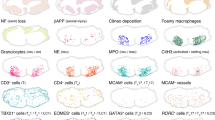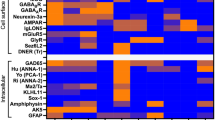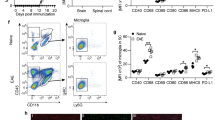Abstract
Background
Multiple sclerosis (MS) is a complex autoimmune disease that affects the central nervous system, causing inflammation, demyelination, and neurodegeneration. Understanding the dysregulation of Tregs, dynamic cells involved in autoimmunity, is crucial in comprehending diseases like MS. However, the role of lymphocyte-activation gene 3 (Lag-3) in MS remains unclear.
Methods
In this study, we explore the potential of exosomes derived from human umbilical cord mesenchymal stem cells (hUMSCs-Exs) as an immune modulator in experimental autoimmune encephalomyelitis (EAE), a model for MS.
Results
Using flow cytometry, our research findings indicate that groups receiving treatment with hUMSC-Exs revealed a significant increase in Lag-3 expression on Foxp3 + CD4 + T cells. Furthermore, cell proliferation conducted on spleen tissue samples from EAE mice using the CFSE method exposed to hUMSC-Exs yielded relevant results.
Conclusions
These results suggest that hUMSCs-Exs could be a promising anti-inflammatory agent to regulate T-cell responses in EAE and other autoimmune diseases. However, further research is necessary to fully understand the underlying mechanisms and Lag-3’s precise role in these conditions.





Similar content being viewed by others
Data availability
No datasets were generated or analysed during the current study.
References
Kuhlmann T, Antel J (2023) Multiple sclerosis: 2023 update. Free Neuropathol 4. https://doi.org/10.17879/freeneuropathology-2023-4675
Alfredsson L, Olsson T (2019) Lifestyle and environmental factors in multiple sclerosis. Cold Spring Harb Perspect Med 9(4). https://doi.org/10.1101/cshperspect.a028944
Huang W-J, Chen W-W, Zhang X (2017) Multiple sclerosis: Pathology, diagnosis and treatments. Experimental and therapeutic medicine 13. 63163–3166. https://doi.org/10.3892/etm.2017.4410
Tavazzi E, Rovaris M, La Mantia L (2014) Drug therapy for multiple sclerosis. CMAJ 186(11):833–840. https://doi.org/10.1503/cmaj.130727
Gao F, Chiu SM, Motan DAL, Zhang Z, Chen L, Ji HL, Tse HF, Fu QL, Lian Q (2016) Mesenchymal stem cells and immunomodulation: current status and future prospects. Cell Death & Disease 7(1): e2062-e2062: https://doi.org/10.1038/cddis.2015.327
Wu X, Jiang J, Gu Z, Zhang J, Chen Y, Liu X (2020) Mesenchymal stromal cell therapies: immunomodulatory properties and clinical progress. Stem Cell Res Ther 11(1):345. https://doi.org/10.1186/s13287-020-01855-9
Seo Y, Kim H-S, Hong I-S (2019) Stem cell-derived extracellular vesicles as Immunomodulatory therapeutics. Stem Cells Int 2019. https://doi.org/10.1155/2019/5126156
Qian X, An N, Ren Y, Yang C, Zhang X, Li L (2021) Immunosuppressive effects of mesenchymal stem cells-derived exosomes. Stem Cell Reviews Rep 17(2):411–427. https://doi.org/10.1007/s12015-020-10040-7
Zhou X, Xie F, Wang L, Zhang L, Zhang S, Fang M, Zhou F (2020) The function and clinical application of extracellular vesicles in innate immune regulation. Cell Mol Immunol 17(4):323–334. https://doi.org/10.1038/s41423-020-0391-1
Wang JH, Liu XL, Sun JM, Yang JH, Xu DH, Yan SS (2020) Role of mesenchymal stem cell derived extracellular vesicles in autoimmunity: a systematic review. World J Stem Cells 12(8):879–896. https://doi.org/10.4252/wjsc.v12.i8.879
Kimura K (2020) Regulatory T cells in multiple sclerosis. Clin Experimental Neuroimmunol 11(3):148. https://doi.org/10.1111/cen3.12591. 155: https://DOI:
Yang S, Fujikado N, Kolodin D, Benoist C, Mathis D (2015) Immune tolerance. Regulatory T cells generated early in life play a distinct role in maintaining self-tolerance. Science 348(6234) 589 – 94: https://DOI. https://doi.org/10.1126/science.aaa7017
McIntosh CM, Alegre M-L (2019) Teamwork by IL-10 + and IL-35 + Tregs. American. J Transplantation 19(8):2147. https://doi.org/10.1111/ajt.15511. 2147: https://DOI
Kumar P, Bhattacharya P, Prabhakar BS (2018) A comprehensive review on the role of co-signaling receptors and Treg homeostasis in autoimmunity and tumor immunity. J Autoimmun 95:77–99. https://doi.org/10.1016/j.jaut.2018.08.007
Pohar J, O’Connor R, Manfroi B, El-Behi M, Jouneau L, Boudinot P, Bunse M, Uckert W, Luka M, Ménager M, Liblau R, Anderton SM, Fillatreau S (2022) Antigen receptor-engineered Tregs inhibit CNS autoimmunity in cell therapy using nonredundant immune mechanisms in mice. European Journal of Immunology 52(8): 1335–1349: https://https://doi.org/10.1002/eji.202249845
Thaker YR, Andrews LP, Workman CJ, Vignali DAA, Sharpe AH (2018) Treg-specific LAG3 deletion reveals a key role for LAG3 in regulatory T cells to inhibit CNS autoimmunity. J Immunol 200(1Supplement):101. https://doi.org/10.4049/jimmunol.200.Supp.101.7
Gertel S, Polachek A, Elkayam O, Furer V (2022) Lymphocyte activation gene-3 (LAG-3) regulatory T cells: an evolving biomarker for treatment response in autoimmune diseases. Autoimmun rev 21(6):103085. https://doi.org/10.1016/j.autrev.2022.103085. https://DOI
Zhang Q, Chikina M, Szymczak-Workman AL, Horne W, Kolls JK, Vignali KM, Normolle D, Bettini M, Workman CJ, Vignali DAA (2017) LAG3 limits regulatory T cell proliferation and function in autoimmune diabetes. Sci Immunol 2(9). https://doi.org/10.1126/sciimmunol.aah4569
Secunda R, Vennila R, Mohanashankar AM, Rajasundari M, Jeswanth S, Surendran R (2015) Isolation, expansion and characterisation of mesenchymal stem cells from human bone marrow, adipose tissue, umbilical cord blood and matrix: a comparative study. Cytotechnology 67(5):793–807. https://doi.org/10.1007/s10616-014-9718-z
Jung MK, Mun JY (2018) Sample Preparation and Imaging of exosomes by Transmission Electron Microscopy. J Vis Exp 131https://doi.org/10.3791/56482
Huntemann N, Vogelsang A, Groeneweg L, Willison A, Herrmann AM, Meuth SG, Eichler S (2022) An optimized and validated protocol for inducing chronic experimental autoimmune encephalomyelitis in C57BL/6J mice. J Neurosci Methods 367. https://doi.org/10.1016/j.jneumeth.2021.109443. 109443: https://DOI
Yin K, Wang S, Zhao RC (2019) Exosomes from mesenchymal stem/stromal cells: a new therapeutic paradigm. Biomark Res 7(1):8. https://doi.org/10.1186/s40364-019-0159-x
Li Y, Li N, Yu X, Huang K, Zheng T, Cheng X, Zeng S, Liu X (2018) Hematoxylin and eosin staining of intact tissues via delipidation and ultrasound. Sci Rep 8(1):12259. https://doi.org/10.1038/s41598-018-30755-5
Sharma VK, Bayry J (2022) Restoration of established systemic inflammation and autoimmunity by Foxp3 + regulatory T cells. Cellular &. Mol Immunol 19(2):133–135. https://doi.org/10.1038/s41423-021-00831-4
Zhang Q, Chikina M, Szymczak-Workman AL, Horne W, Kolls JK, Vignali KM, Normolle D, Bettini M, Workman CJ, Vignali DAA (2017) LAG3 limits regulatory T cell proliferation and function in autoimmune diabetes. Sci Immunol 2(9):eaah4569. https://doi.org/10.1126/sciimmunol.aah4569
Verma ND, Lam AD, Chiu C, Tran GT, Hall BM, Hodgkinson SJ (2021) Multiple sclerosis patients have reduced resting and increased activated CD4 + CD25 + FOXP3 + T regulatory cells. Sci Rep 11(1):10476. https://doi.org/10.1038/s41598-021-88448-5
Yu S, Fujio K, Ishigaki K, Shoda H, Okamura T, Noor T, Sumitomo S, Yamamoto K (2012) Increased concentration of serum soluble LAG3 in systemic lupus erythematosus. Arthritis Res Ther 14(Suppl 1):P16. https://doi.org/10.1186/ar3617Epub 2012 Feb 9
Kato R, Sumitomo S, Tsuchida Y, Tsuchiya H, Nakachi S, Sakurai K, Hanata N, Nagafuchi Y, Kubo K, Tateishi S, Kanda H, Okamura T, Yamamoto K, Fujio K (2019) CD4 + CD25 + LAG3 + T cells with a feature of Th17 cells Associated with systemic Lupus Erythematosus Disease Activity. Front Immunol 10. https://doi.org/10.3389/fimmu.2019.01619
Lundmark F, Harbo HF, Celius EG, Saarela J, Datta P, Oturai A, Lindgren CM, Masterman T, Salter H, Hillert J (2006) Association analysis of the LAG3 and CD4 genes in multiple sclerosis in two independent populations. J Neuroimmunol 180(1):193–198. https://doi.org/10.1016/j.jneuroim.2006.08.009. https://DOI
García-Martín E, Agúndez JAG, Gómez-Tabales J, Benito-León J, Millán-Pascual J, Díaz-Sánchez M, Calleja P, Turpín-Fenoll L, Alonso-Navarro H, García-Albea E, Plaza-Nieto JF, Jiménez-Jiménez FJ (2022) Association between LAG3/CD4 genes variants and risk for multiple sclerosis. Int J Mol Sci 23(23):15244
Kadowaki A, Miyake S, Saga R, Chiba A, Mochizuki H, Yamamura T (2016) Gut environment-induced intraepithelial autoreactive CD4(+) T cells suppress central nervous system autoimmunity via LAG-3. Nat Commun 7(11639). https://doi.org/10.1038/ncomms11639
Do J, Kim D, Kim S, Valentin-Torres A, Dvorina N, Jang E, Nagarajavel V, DeSilva TM, Li X, Ting AH, Vignali DAA, Stohlman SA, Baldwin WM, Min B (2017) Treg-specific IL-27Rα deletion uncovers a key role for IL-27 in Treg function to control autoimmunity. Proceedings of the National Academy of Sciences 114(38): 10190–10195: https://DOI: https://doi.org/10.1073/pnas.1703100114
Maruhashi T, Sugiura D, Okazaki IM, Okazaki T (2020) LAG-3: from molecular functions to clinical applications. J Immunother Cancer 8(2). https://doi.org/10.1136/jitc-2020-001014
Jones A, Opejin A, Henderson JG, Gross C, Jain R, Epstein JA, Flavell RA, Hawiger D (2015) Peripherally Induced Tolerance Depends on Peripheral Regulatory T Cells that require Hopx to inhibit intrinsic IL-2 expression. J Immunol 195(4):1489. https://doi.org/10.4049/jimmunol.1500174
Kitz A, Dominguez-Villar M (2017) Molecular mechanisms underlying Th1-like Treg generation and function. Cellular. Mol Life Sci 74(22):4059–4075. https://doi.org/10.1007/s00018-017-2569-y
Maeda TK, Sugiura D, Okazaki IM, Maruhashi T, Okazaki T (2019) Atypical motifs in the cytoplasmic region of the inhibitory immune co-receptor LAG-3 inhibit T cell activation. J Biol Chem 294(15):6017–6026. https://doi.org/10.1074/jbc.RA119.007455
Kleinewietfeld M, Hafler DA (2013) The plasticity of human Treg and Th17 cells and its role in autoimmunity. Semin Immunol 25(4) 305 – 12: https://DOI:. https://doi.org/10.1016/j.smim.2013.10.009
Dabrowska S, Andrzejewska A, Janowski M, Lukomska B (2021) Immunomodulatory and Regenerative effects of mesenchymal stem cells and extracellular vesicles: Therapeutic Outlook for Inflammatory and degenerative diseases. Front Immunol 11. https://doi.org/10.3389/fimmu.2020.591065
Negi N, Griffin MD (2020) Effects of mesenchymal stromal cells on regulatory T cells: current understanding and clinical relevance. Stem Cells 38(5):596–605. https://doi.org/10.1002/stem.3151. https://DOI
Gomzikova MO, James V, Rizvanov AA (2019) Therapeutic application of mesenchymal stem cells derived Extracellular vesicles for Immunomodulation. Front Immunol 10(2663). https://doi.org/10.3389/fimmu.2019.02663
Willis GR, Mitsialis SA, Kourembanas S (2018) Good things come in small packages: application of exosome-based therapeutics in neonatal lung injury. Pediatr Res 83(1–2):298–307. https://doi.org/10.1038/pr.2017.256
Di Trapani M, Bassi G, Midolo M, Gatti A, Takam Kamga P, Cassaro A, Carusone R, Adamo A, Krampera M (2016) Differential and transferable modulatory effects of mesenchymal stromal cell-derived extracellular vesicles on T, B and NK cell functions. Sci Rep 6(1):24120. https://doi.org/10.1038/srep24120
Zhang B, Yeo RWY, Lai RC, Sim EWK, Chin KC, Lim SK (2018) Mesenchymal stromal cell exosome–enhanced regulatory T-cell production through an antigen-presenting cell–mediated pathway. Cytotherapy 20(5):687–696. https://doi.org/10.1016/j.jcyt.2018.02.372. https://DOI
Varderidou-Minasian S, Lorenowicz MJ (2020) Mesenchymal stromal/stem cell-derived extracellular vesicles in tissue repair: challenges and opportunities. Theranostics 10(13):5979–5997. https://doi.org/10.7150/thno.40122
Acknowledgements
We would like to express our gratitude to Dr. Behzad Baradaran and Elham Baghbani, Tabriz University of Medical Sciences, for their assistance in performing flow cytometry.
Funding
Not applicable.
Author information
Authors and Affiliations
Contributions
Mohammadzadeh Adel, designed and performed many of the experiments and conceptual interpretations. Masoud Lahouti, Hamed, Arash and Sahand were involved in performing the practical examination.Jafar Rezaei helped in exosome isolation and interpretation. Shahria Alipour and Vahid designed and Helped in RT-PCR. Dr Hassan Ansari revised the manuscript. All authors read and approved the final manuscript.
Corresponding author
Ethics declarations
The authors declare that they have no known competing financial interests or personal relationships that could have influenced the work reported in this paper.
Ethical approval
This study was granted by the Ethics Committee of the Urmia University of Medical Science Animal Ethics Committee (IR.UMSU.REC.1399.069).
Competing interests
The authors declare no competing interests.
Additional information
Publisher’s Note
Springer Nature remains neutral with regard to jurisdictional claims in published maps and institutional affiliations.
Electronic supplementary material
Below is the link to the electronic supplementary material.
Rights and permissions
Springer Nature or its licensor (e.g. a society or other partner) holds exclusive rights to this article under a publishing agreement with the author(s) or other rightsholder(s); author self-archiving of the accepted manuscript version of this article is solely governed by the terms of such publishing agreement and applicable law.
About this article
Cite this article
Mohammadzadeh, A., Lahouty, M., charkhian, H. et al. Human umbilical cord mesenchymal stem cell-derived exosomes alleviate the severity of experimental autoimmune encephalomyelitis and enhance lag-3 expression on foxp3 + CD4 + T cells. Mol Biol Rep 51, 522 (2024). https://doi.org/10.1007/s11033-024-09433-5
Received:
Accepted:
Published:
DOI: https://doi.org/10.1007/s11033-024-09433-5




